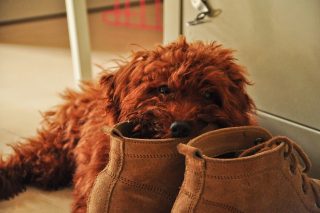It may be difficult to imagine after so many months of stress and disruptions, but COVID-19 won’t last forever. Someday, hopefully soon, we’ll all be back in our offices. We will be free to see our friends and family. We’ll be able to travel without restriction. We’re all eagerly looking forward to this return to normalcy. Our pets, however, have no idea what’s going on now, and they won’t understand why we start to leave them again. We may occasionally envy them for their lack of knowledge, but ignorance isn’t always bliss. Unexplained routine changes can upset pets, and they may experience separation anxiety.
Helping Pets With Post COVID Separation Anxiety
New Toys and Enrichment
Toys and other enrichment opportunities are some of the best ways to combat the boredom and anxiety your pet may experience. Look for products that your pet will enjoy, even when you aren’t around to play with them. Feeders that your pets have to interact with for each piece of kibble will keep them occupied. Like us, animals tend to eat when they’re bored or stressed. S0 products like these have the added benefit of acting as both portion control and exercise.
For dogs, shop for products they can safely chew on without the risk of accidental ingestion or making a mess if they shred the item. Cats, for their part, like trees and towers they can climb, explore, and nap in. They especially like it if the tree is positioned so they can see out a window. Pedestrians, traffic, and wildlife offer hours of entertainment. You can get a wide variety of pet toys and other accessories for them at Pet Life.
Try Practicing Being Gone
Getting your pet used to you leaving is challenging in any situation. However, it can feel impossible with the ongoing COVID-19 pandemic since you’re not supposed to be going anywhere. For many pets with separation anxiety, being left alone is traumatic. When they act out, and you punish them for it, you reinforce the idea that bad things happen when you leave.
Short trips outside without your pet, even if all you do is walk around the block or check the mail, help build a collection of memories for your pet where you left, and nothing upsetting happened. Doing so can reduce anxiety. Make sure they somehow keep themselves occupied while you’re gone. That way, your pet builds more positive associations. That’s where treats and toys come in.
Stick to a Routine
Animals find routines comforting, and they learn them quickly. Anyone with a cat used to being fed at a specific time can attest to that. For dogs, walk them at the same time every morning, and again in the evening at the time you would when you got home from work. For both cats and dogs, keep feeding times constant no matter what kind of schedule you keep. The sense of stability a routine provides, even whether you’re at home or not, can help your pets feel less anxious.
Understand the Signs
You can’t help your pets with post-COVID separation anxiety if you don’t recognize the associated signs and symptoms. Many dogs with separation anxiety or who are likely to develop separation anxiety share the same behaviors. If your pet seems nervous or upset when they hear the sound of keys or see you putting on shoes, or they follow you everywhere around the house, they may be more likely to experience separation anxiety.
Behaviors associated with separation anxiety that occur after you leave your home include excessive barking and whining, destructive behaviors focused on themselves or items in your home, urinating or defecating at inappropriate times, or outside designated areas.
These behaviors may cause the dog to be given up to a shelter. A dog who has been given up for separation anxiety before is even more likely to experience it with a new owner. Dogs with separation anxiety are also more likely to vomit or have diarrhea. They may also refuse to eat and exhibit signs of depression. While most dogs are excited when you come home, dogs with separation anxiety may be excessively enthusiastic.
With cats, of the research that exists, much of it looks at cats who experience the signs of separation anxiety we’re used to seeing in dogs. While limited, the existing body of evidence points out that cats experience separation anxiety despite our idea of them as independent, aloof animals. Unlike dogs, however, cats are more likely to display signs of separation anxiety when their favorite person leaves, whether other humans are around.
Final Thoughts
The good news is that you spoiling your pet won’t increase the odds of separation anxiety; hence, you can make the most of your time at home together guilt-free. The bad news is that separation anxiety can be challenging and time-consuming to manage. However, with the right supplies, training, and education, you and your pet can adjust to a post-COVID world more easily. You should also educate yourself about the signs of separation anxiety so you can recognize them for what they are.
This Post is Longevity Live Partnered Content.
Links referred to:
- https://www.petlife.com/
- Pet life link from assignment description
- https://www.researchgate.net/profile/Nicholas_Dodman/publication/11827860_Risk_factors_and_behaviors_associated_with_separation_anxiety_in_dogs/links/0c960531f33f35d8ba000000/Risk-factors-and-behaviors-associated-with-separation-anxiety-in-dogs.pdf
- A scholarly article on behaviors and risk factors associated with separation anxiety in dogs
- https://pdfs.semanticscholar.org/441a/0eb784f790aaf7542eba3b869ae276960776.pdf
- A similar article on cats and separation anxiety







![women [longevity live]](https://longevitylive.com/wp-content/uploads/2020/01/photo-of-women-walking-down-the-street-1116984-100x100.jpg)









